All photos on this page: Kaku Suzuki
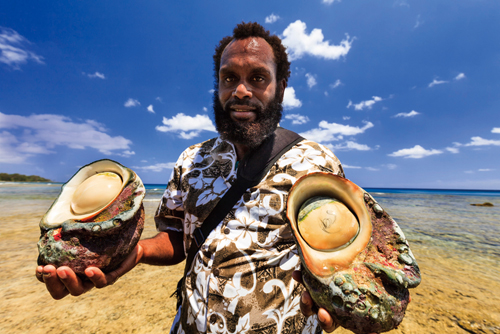
A trainee holding green snails in the coastal area of Mangaliliu village. This valuable shellfish is used for creating mother-of-pearl crafts, including the one found in Konjiki-do (the golden hall) in Chusonji temple, a World Heritage site in Japan's Iwate prefecture.
Vanuatu, consisting of more than 80 large and small islands, lies in the Pacific to the east of Australia. Its coastal areas are blessed with rich ecosystems, including coral reefs. However, growing demand has endangered some fishery resources, such as the turbo marmoratus, which is locally called green snail. Currently a community-based resource management approach is finding success in reviving coastal shellfish populations that are valuable to the country's culture and economy.
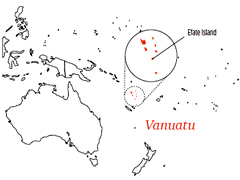
DEPLETED GREEN SNAIL POPULATION: TEACHING INHABITANTS TO MANAGE RESOURCES SUSTAINABLY
Traditionally in Vanuatu people gather food in the shallows along the coast, which are referred to locally as the `coastal area.' Women walk in the shallows to pick shellfish and men go by canoe to fish in deeper waters. Even in this modern era, that lifestyle has not changed. However, in recent years, the human population has been increasing, and the resources of the coastal area have been rapidly shrinking. Green snail, in particular, which have high commercial value as material for mother-of-pearl inlay crafts, were harvested excessively from the late 1980s to the early 1990s. They almost completely disappeared from Efate Island, on which the capital, Port Vila, is located. The loss of this valuable resource reduced the income of many fishers.
Proper management is essential to the restoration of the resource-rich coastal areas. In Vanuatu, coastal resources have traditionally been managed by local communities under the supervision of a community chief. However, the effectiveness of that approach was limited. For example, there was no planned approach to fishing outside the non-fishing areas.
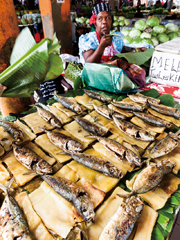
Fish is a precious protein source in Vanuatu. In the market, lap lap, a traditional pudding-like dish with fish, is sold.
JICA's technical cooperation project, `The Project for the Promotion of the Grace of the Sea in Coastal Villages,' was launched in 2006 to help Vanuatu manage its coastal resources. JICA experts worked with the Vanuatu Fisheries Department (VFD) of the Ministry of Agriculture, Livestock, Forestry, Fisheries and Biosecurity (MALFFB). Together, they decided to focus on giant clams and green snails because the growth of these resources could be observed easily. In the first phase of the project, juvenile shellfish were released and mature shellfish were transplanted into four coastal communities of Efate Island; after that, and a resource management plan was drawn up.
The second phase of the project, which began in 2011 on Efate Island and two other islands, focused on activities to establish community-based coastal resource management (CBCRM). Using techniques based on Vanuatu's own resource management practices, in each community, a CBCRM committee was created by the community itself under the direction of the community chief, with expert advice from the Fisheries Department, to formulate rules for proactive resource management, such as setting non-fishing areas and non-fishing species.
Akiya Seko, a senior consultant from Japan's IC Net, Ltd., who supported the creation of the committee as a JICA expert, says, "The Fisheries Department advised that young people and women, who have weak political voices, should be included in the committee, and in response we stipulated that any resident could be involved in resource management."
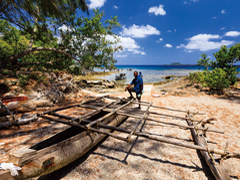
Outrigger canoes are still commonly used in Vanuatu.
The promotion of a voluntary approach brought a shift in the awareness of the local fishers. For example, on Lelepa Island, to the north of Efate Island, when super cyclone Pam struck in March 2015, the island's CBCRM committee was called upon to respond to the emergency. Max Kalsong, a CBCRM committee member and authorized fisheries officer of the local committee for the promotion of the project, proposed that the non-fishing areas be opened to secure food supplies. Similar measures were taken in other areas, but in many cases, the non-fishing areas remained open even after the emergency situation ended. While the areas were open, Kalsong continued to monitor them, and he returned the areas to the non-fishing status one month later as there were prospects of other means of securing food. "If I had not learned the importance of resource management through working on that project, I might have neglected the areas, too," says Kalsong.
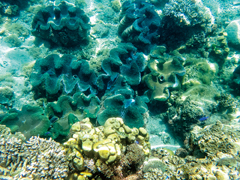
Giant clams near Mangaliliu Village. The mother shells that were transplanted from Tonga in the first phase of the project have grown and are now being cultivated.
On Aneityum Island, one action that was seen as necessary was to give the clans who are long-term owners of coastal areas an understanding of resource management activities. When the CBCRM committee respectfully explained to the owners the management principles, they understood their significance. As a result, six areas were designated for control by the committee and the work proceeded successfully. The effort to protect green snails was successful. The mother green snails, which were released on Efate Island, came from Aneityum Island. Rewben Neriam, an authorized fisheries officer, says, "Large cruise ships frequently come to this island from countries such as Australia. The increase in our coastal resources will support tourism, which will in turn increase our motivation to engage in resource management."
Results show that changes in the community are leading to resource recovery. When the third phase of the project began in March of 2017, it was confirmed that giant clams and green snails, whose juvenile and mature shellfish had been released in the first phase, were breeding extensively. "I was very excited when I confirmed that new shellfish were born in some locations on Efate Island," says Sompert Gereva, a manager at the Research and Aquaculture Division of the VFD, as he looks back on those days.
TRAINING IN MANGALILIU VILLAGE: SEEING ALTERNATIVE MEANS OF LIVING
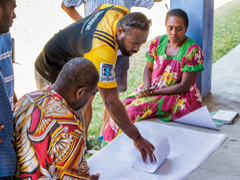
Amos of the VFD (second from left) explains the content of a debate to a trainee.
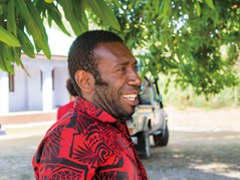
Mor Mor, the young chief of Mangaliliu Village. Taking over from his predecessor, who died in 2016, Chief Mor Mor has been actively promoting resource management.
One of the areas where the shellfish population revival was confirmed is Mangaliliu Village, on northern Efate Island. In October 2017, in a project staff training activity, the trainees visited shallows and excitedly looked for shells. One staff member held up two green snails bigger than the palm of his hand, and posed for a photo. Village Chief Mor Mor says, "For some time there has been a resource management organization in this village, but I must say it was not functioning well. In this project, we adjusted our approach by drawing on the example of Aneityum Island, and now the community members can manage these resources in accordance with the rules."
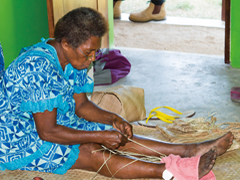
A woman in Mangaliliu Village knitting a pouch from pandanus leaves. These knitted goods are sold along with shellfish crafts at the souvenir shop at the entrance to the village.
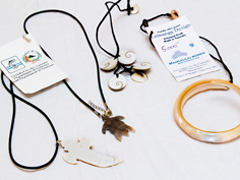
Shellfish crafts with eco labels attached. Japan Overseas Cooperation Volunteers affiliated with the VFD collaborated in the creation of the labels.
However, it is not easy to maintain the local people's motivation, as setting a management area of the sea for harvesting imposes limits on the residents' food supply and income sources in the short run. For this reason, the project also aims at diversifying the residents' livelihoods. Efforts include the introduction of fish aggregating devices for fishing off the coast and the use and management of solar refrigerators to support distribution. Mangaliliu Village is also supporting the development of women's shell crafts. In addition to supplying the materials for polishing shells beautifully, Japanese experts met with the village women to discuss ways to improve the production costs and design of their crafts. A local `Eco Label' was created to indicate that these products were made by the groups who endeavored to manage coastal resources.
Two people who joined the training and took an interest in the local shell crafts are George Frank, authorized fisheries officer from Emae Island, and Wilson Roy Peter, a representative of an existing Emae Island resource management organization called Fenuataii (which means "land and sea" in the local language). The project will start at full scale on Emae in 2018. "We have already set the non-fishing areas, but we have not established a management approach, so we hope to learn a lot from the experience of other villages," he says eagerly.
After an investigative tour of the village, the trainees gathered at a meeting place and held small-group discussions. "With regard to the efforts of Mangaliliu Village, please discuss whether this approach is sustainable or not, from four perspectives including resources and economics," instructed George Amos, from the Development & Capture Division of the VFD. He has been working with Japanese experts to implement community-based resource management in each community. Seko and the others watched quietly as Amos directed the training sessions. The objective was to raise participants' awareness of such issues as who is responsible for decision making and who is affected by those decisions.
At the beginning, this project proceeded under a top-down approach and staff members of the VFD tended to impose ideas on community members. However, Amos said that such attitudes have changed, as he looks towards the Japanese experts who provided such warm, respectful support to the people. Amos says, "Basically, our organization takes a top-down approach, but I came to know for the first time of a different approach, a community-based means of moving forward."
Amos also suggested that Seko promote provincial government involvement in this project. In response, Seko began work to develop a structure for the creation of a resource management plan centered around an area council within each provincial government. Each area council would be in charge of development planning for its area. "The community might find it confusing if they were given separate explanations by various departments, such as advice on resource management from the Fisheries Department and input on hygiene from the Health Department. If the area councils could explain to the local people how resource management would be connected with other fields and how that work would ultimately lead to the development of the community, it would eventually deepen the understanding of the community, making it possible to present an integrated, overall development plan to the project members," Seko explains. On Emae Island, Christopher Daniel, the area secretary who is developing the plan under the area council, is working with the project with an awareness of the need for cooperation. "Currently, we are creating development plans not just for resource management, but also for six areas of concern, including agriculture, youth issues, and support for the disabled. We are planning with the connections between fields in mind."
BEYOND THE PROJECT: ENCOURAGING COMMUNITY-BASED MANAGEMENT
The project will also promote the fisheries industry in matters such as cultivating tilapia, developing efficient distribution routes, and processing fish products such as dried and smoked fish. William Naviti, Acting Director of the Fisheries Department, says, "I was impressed by this project: It is not just providing materials, it's also taking the time to change the local people's way of thinking. We formulated a new fisheries policy at the end of 2016 and incorporated the promotion of community-based coastal resource management in that policy. This shows our determination to continue these activities even after the project is over."
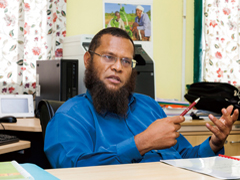
Benjamin Shing, Acting Director General of Vanuatu's Ministry of Agriculture, Livestock, Forestry, Fisheries and Biosecurity.
A person who plays an important role in aligning the project with the overall government policy is Nepcevanhas Benjamin Shing, Acting Director General of the MALFFB. He had been involved in the formulation of Vanuatu's National Sustainable Development Plan ‘Vanuatu 2030', which has three integrated pillars: society, environment and economy.
Traditionally, the government's development plans focused primarily on the economic aspects. The Vanuatu 2030 uses a triple bottom line approach that integrates environmental and social elements as integral parts of development. It recognizes that environmental and social aspects are as important as, and intertwined with, economic aspects in achieving sustainable socioeconomic growth. Shing believes that JICA's project epitomizes this ideology, and therefore helps to illustrate it.
In its own efforts, Vanuatu took up Japan's vision of seeking ways of coexisting with nature. The Solomon Islands, a neighboring country, is paying attention to the experiences of Vanuatu, and JICA is now conducting field surveys there with the intention of starting a new project. Japan will continue to watch the unfolding of community-based coastal resource management, which has already begun to spread across Oceania.




scroll